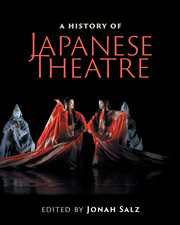Book contents
- Frontmatter
- Contents
- List of figures
- List of tables
- Contributors
- Contributors’ biographies
- Foreword
- Acknowledgments
- Note on Japanese terms
- List of abbreviations
- Timeline
- Editor's introduction
- I Traditional theatres
- Preface to Part I Japanese civilization arises
- 1 Ancient and early medieval performing arts
- Interlude Katari narrative traditions: from storytelling to theatre
- 2 Noh and Muromachi culture
- Interlude Noh and kyogen costumes and masks
- 3 Kyogen: classical comedy
- Interlude Iemoto : the family head system
- 4 Kabuki: superheroes and femmes fatales
- Interlude Nihonbuyo: classical dance
- Interlude Okinawan theatre: boundary of Japanese theatre
- 5 Bunraku: puppet theatre
- Interlude Misemono and rakugo : sideshows and storytelling
- Interlude Kamigata geinō : Kyoto-Osaka style
- Interlude Traditional theatre tomorrow: interview with Takemoto Mikio
- II Modern theatres
- Preface to Part II
- III Arcs and patterns
- IV Theatre architecture
- Preface to Part IV Evolution of Japanese theatre architecture
- V Theatre criticism
- VI Intercultural influences
- Epilogue: Frozen words and mythology
- Further reading
- Index
- References
1 - Ancient and early medieval performing arts
from Preface to Part I Japanese civilization arises
Published online by Cambridge University Press: 05 July 2016
- Frontmatter
- Contents
- List of figures
- List of tables
- Contributors
- Contributors’ biographies
- Foreword
- Acknowledgments
- Note on Japanese terms
- List of abbreviations
- Timeline
- Editor's introduction
- I Traditional theatres
- Preface to Part I Japanese civilization arises
- 1 Ancient and early medieval performing arts
- Interlude Katari narrative traditions: from storytelling to theatre
- 2 Noh and Muromachi culture
- Interlude Noh and kyogen costumes and masks
- 3 Kyogen: classical comedy
- Interlude Iemoto : the family head system
- 4 Kabuki: superheroes and femmes fatales
- Interlude Nihonbuyo: classical dance
- Interlude Okinawan theatre: boundary of Japanese theatre
- 5 Bunraku: puppet theatre
- Interlude Misemono and rakugo : sideshows and storytelling
- Interlude Kamigata geinō : Kyoto-Osaka style
- Interlude Traditional theatre tomorrow: interview with Takemoto Mikio
- II Modern theatres
- Preface to Part II
- III Arcs and patterns
- IV Theatre architecture
- Preface to Part IV Evolution of Japanese theatre architecture
- V Theatre criticism
- VI Intercultural influences
- Epilogue: Frozen words and mythology
- Further reading
- Index
- References
Summary
A number of important Japanese performing arts (geinō, 芸能) flourished before the appearance of the first dramatic forms, noh-kyogen, in the mid-fourteenth century. Some ancient geinō even offer complex stories using words, music, and dance. Performances or rituals played at court, Buddhist temples, and Shinto shrines influenced later theatrical spectacle. Some survived, but others are traceable only through historical records, literature, or picture-scrolls.
Ancient performing arts show diversity in origin, patronage, and style. Some were imported directly from the Asian continent under the Yamato government's (fourth to seventh centuries AD) policy of progress through assimilation, while others are native to the Japanese archipelago. Some arts supported by the nobility were highly refined; others, enjoyed by the lower classes, were wild and dynamic. These arts were neither perfected nor isolated, but rather continuously mutually influenced each other. Some arts descended from and replaced older ones, while others intertwined to bring about new hybrids. This continuous recombination of court, folk, and religious genres is a defining feature of the fluid premedieval performing arts.
Continental imports: gigaku, sangaku, bugaku
Japan's interaction with the Asian continent was especially active during the seventh and eighth centuries, with the systematic introduction of Korean and Chinese arts that then became established in Japan via continuous transmission within permanent institutions.
Gigaku (伎楽)
Masked pantomime gigaku, also known as kuregaku 呉楽 (lit., ‘music of China's Wu dynasty [222–80 AD]’), is one of Japan's earliest foreign performing arts. According to The Chronicles of Japan (Nihonshoki a.k.a. Nihongi), gigaku was introduced in 612 AD by Mimashi from the ancient Korean kingdom Paekche, who taught it in Nara. Gigaku was staged for the “eye-opening ceremony” of the Great Buddha in the Tōdaiji Temple in 752 AD and other annual, religious events.
Gigaku masks cover the entire head, unlike the smaller ones used in noh, and some are quite realistic and grotesque. According to the musical treatise Kyōkunshō (Anthology of lessons, 1223), gigaku was accompanied by flute, hip-drum, and cymbals.
- Type
- Chapter
- Information
- A History of Japanese Theatre , pp. 4 - 19Publisher: Cambridge University PressPrint publication year: 2016
References
- 1
- Cited by



